“Why are there so many songs about rainbows,
and what’s on the other side?”
In 1979, the Muppets were at the peak of their popularity. The Muppet Show had been running since 1976, and children and adults both regularly tuned in to watch the silly, surreal antics of Kermit the Frog and his cast of performers attempt to put on a show every week. The time was ripe for Jim Henson, Frank Oz, and the rest of the Muppet performers to take the characters to the next level, to produce a movie: The Muppet Movie. The feature-length format allowed them to tell a complete story, the story of how the Muppets first came together. “Well, it’s sort of approximately how it happened,” as Kermit tells his nephew Robin. The movie starts out with the Muppets attending the private screening of their own film, and that subversive meta-humor peppers the entirety of the movie. The movie is filled with lots of other kinds of humor as well, from character humor, pop culture references, situational irony, running gags and hilariously bad puns. It also throws in some sentimentality, some excitement, some music, and a whole herd of guest stars.
“Can you help me? I have lost my sense of direction.”
“Have you tried Hare Krishna?”
As the film within the film starts, the first of those guest stars arrives as Dom DeLuise, playing a thoroughly lost talent agent, hears the sound of Kermit singing “The Rainbow Connection”. The first of several songs written by Paul Williams and Kenny Ascher especially for the movie, “The Rainbow Connection” has become as closely associated with the Muppets as the Muppet show theme song itself. It’s doubtful any other song, even “It’s Not Easy Being Green”, is thought of more often when people mention Muppet songs. It was even re-used, in slightly abridged form (cutting the second verse), for the 2011 revival movie, The Muppets. “The Rainbow Connection” was nominated for an Oscar and a Golden Globe for Best Original Song; the score was also Oscar-nominated, and the soundtrack won a Grammy. “The Rainbow Connection” would eventually be placed at #74 on the AFI’s list of 100 years, 100 songs. It’s a hauntingly beautiful song, and sets the mood of the film well; though The Muppet Movie is a very funny comedy, it has its sentimental side as well, and ultimately it’s all about the magic.
Part of that magic comes in the form of being able to do things the Muppet performers couldn’t do before. The larger budget and production time of the movie allowed them to work out puppeteering effects that were unfeasible for The Muppet Show. On the show, it was rare to see the legs of the Muppets; the Muppets are controlled from below, and so showing their legs requires elaborate set building as well as finding a place to hide the performers. Remote controls, hidden wires, and more allowed The Muppet Movie to show the Muppets in full, interacting with their environment in ways they simply couldn’t before, even placing them in environments that were unfeasible before. Looking at the opening scenes, with Kermit in the swamp, it’s easy to wonder where Jim Henson is. The answer is that Henson is where he always was: underneath Kermit. Which in this case meant being under the water, in a 50-gallon steel container, with a breathing tube, a rubber glove extending out, and a monitor so he could see what he was doing. It took five days to film (and three Kermit puppets), showing a tremendous dedication to his craft.
“That’s pretty dangerous, building a road in the middle of the street.”
It’s soon followed by another technical achievement, as Kermit, inspired by the thought of making millions of people happy through becoming a star, sets out for Hollywood while bicycling. In his review, Roger Ebert wrote “if you can figure out how they were able to show Kermit pedaling across the screen, then you are less a romantic than I am: I prefer to believe he did it himself.” And the scene, though not the most difficult of the feats according to Henson and Oz, captured the imagination of the audience-going public. Nobody could believe they could do such a thing… so just to top it, they included a scene with several bicycling Muppets in The Great Muppet Caper.
Kermit’s bike ride quickly leads to a couple of fateful meetings, as he enters the El Sleezo cafe, a joint so tough that even owner James Coburn gets thrown out. The cafe is filled with cameos, in fact, with Madeline Kahn and Telly Savalas as fellow patrons, and Paul Williams himself playing the part of the pianist. And, of course, Carol Kane as the running gag Miss Myth. (“Yeth?”) But more importantly, it’s here that Kermit encounters the first of his fellow Muppets, as Fozzie Bear tries to perform in front a particularly unruly crowd. His jokes not being any better than they are in The Muppet Show, things quickly get ugly.
“If you think this crowd’s ugly, you should see the dancing girls.”
Kermit tries to help Fozzie out by joining him a dancing routine, and outside the club he’s spotted by a young man who saw him bicycling before. Max, played by Austin Pendleton, calls over his boss, Doc Hopper. Doc Hopper is played by Charles Durning, as a southern gentleman and a sinister parody of Colonel Sanders. Doc Hopper sees the singing, dancing, joke-telling frog and he knows he’s found the perfect mascot for his chain of fried frog leg restaurants. Kermit, of course, isn’t interested, but Doc Hopper refuses to take no for an answer. And so early in the movie we have the basic plot elements in place: Kermit travels from Florida to Hollywood, picking up new friends along the way, and trying to escape the clutches of the villainous Doc Hopper.
The film was directed by James Frawley, the only time during Henson’s life that a Muppet film was directed by somebody outside the fold. According to Austin Pendleton, Frawley was very unhappy while directing the film, and so the cast and crew were largely unhappy. Bitter remarks from a cast member are nothing new in Hollywood, and it would be easy to assume Pendleton had some personal beef, but as Pendleton tells it, Frawley went out of his way to help him at a time when he needed it. Pendleton had been a stage actor who was down on his luck when Frawley approached him to take the role; Pendleton was initially unsure, but Frawley had writers Jerry Juhl and Jack Burns expand the role of Max to make it more appealing. Working on the film led to a friendship with Charles Durning, and Durning helped get Pendleton a role in his next film, Starting Over. But Pendleton notes that getting through The Muppet Movie was very difficult due to strife on the set. The source of Frawley’s displeasure isn’t spelled out, but it’s not hard to guess that he ran into conflicts with Jim Henson and Frank Oz, notorious perfectionists who would logically want to have the movie of their characters run their way. Whatever the cause, it was the only one of the three Jim Henson-era Muppet movies to be directed by an outsider. Jim Henson himself took the chair for The Great Muppet Caper, and Frank Oz helmed The Muppets Take Manhattan. As for Frawley, he primarily went to work in television, with his sole theatrical feature afterward being 1985’s Fraternity Vacation.
“Ah, a bear in his natural habitat: a Studebaker.”
Fozzie and Kermit hit the road, in Fozzie’s uncle’s Studebaker (most of the cars in the movie are from the 40s and 50s, befitting the flashback nature of the film), and the next musical number, “Moving Right Along” kicks in. The first few notes the song return throughout the film as a leitmotif whenever the Muppets resume their voyage. Williams and Ascher show their own comedic talent here, as Fozzie’s lines in the song are some of the funniest things in a very funny movie. (Truthfully, Fozzie gets the best lines throughout the movie as a whole.) As the song describes their journey, Fozzie keeps distressing Kermit with lines such as “sadly we just left Rhode Island!” and “send someone to fetch us, we’re in Saskatchewan”, showing just how far off course his driving has taken them. Williams noted in an interview that Jim Henson gave them a lot of creative freedom, waiting until they were recording in the studio to hear the songs, with blind faith that he would love them. Since Williams and Ascher are responsible for all but one song on the soundtrack, Henson must have felt his faith was lived up to, and small wonder; all of the songs in the film are great and perfectly fit the mood of the picture.
“Maybe we should offer him a ride?” “I don’t know. He’s pretty big.”
Mid-song, Kermit and Fozzie encounter the movie’s biggest cameo, with Carroll Spinney as Big Bird. It’s a cross-over scene that sadly doesn’t seem to be possible any more. The Sesame Street characters were created for and owned by the Children’s Television Workshop (renamed in 2000 to Sesame Workshop after their biggest hit), but back in the 1970s, it was still Jim Henson and the Muppet performers working with the characters. Everything was amicable in those days, and a “Big Bird courtesy of Children’s Television Workshop” in the end credits was all it took. Later, with the sale of the Muppets to Disney, and Sesame Workshop having the Sesame Street characters, and Jim Henson Studios holding on to characters that weren’t owned by either, things are sadly a bit of a mess. When the 2011 film The Muppets was being written, Jason Segel and Nicholas Stoller wanted to include Elmo in a scene with the joke being that the Muppets wanted him to host the telethon but his lawyers advised him against it. The scene was scuttled… because they couldn’t get the legal teams to clear it. Similarly, DVDs of the Henson production The Christmas Toy omit Kermit’s introduction (the older VHS copies include it), and A Muppet Family Christmas is in DVD limbo due to the many rights that need to be worked out; as it includes the Muppets, the Sesame Street characters, and the Fraggles, it has characters from all three studios (it made it to DVD once in 2003, but is again out of print). I can’t imagine this bureaucratic mess is what Jim Henson would have wanted. They were all, in Henson’s eyes, Muppets, and Big Bird’s cameo in The Muppet Movie is a wonderful nod to this unified concept.
“They don’t look like Presbyterians to me.”
In an abandoned church, Fozzie and Kermit find Dr. Teeth and the Electric Mayhem. In lieu of explaining their plight, and thus recapping the entire movie (“you’ll bore the audience!”), they simply hand them the screenplay. It’s a great bit of meta-humor; as Kermit says in the beginning, it’s only approximately how the Muppets met. The events shown in The Muppet Movie aren’t how the Muppets got together, they’re the events of the movie of how they got together. There’s a cheerful acceptance of the absurd that is right at home with the productions of The Muppet Show. And with a psychedelic rock number, “Can You Picture That?” the Electric Mayhem helps the duo out by disguising their car. They don’t follow along though, not yet; the screenplay has other plans for them.
“I don’t know how to thank you.” “I don’t know why to thank you.”
Fozzie and Kermit continue on their way, and begin accruing more Muppets. They meet Gonzo, swap cars, and then meet Miss Piggy at a country fair and beauty pageant. There’s a touching tribute to Edgar Bergen here, as he and Charlie McCarthy are acting as the judges. This was Bergen’s final film role, and Henson wanted to include him for being the inspiration for Henson’s own work in puppetry; the film is dedicated to his memory. The romantic song that springs up when Miss Piggy meets Kermit’s eyes is a bit overdone, but it’s all right, as it’s more than a little self-aware of how over-the-top it is. And it doesn’t take long for the film to get right back to the comedy. With the mercantile assistance of Richard Pryor as a balloon salesman, the group winds up nearly losing Gonzo as he’s taken aloft by a large bundle of helium balloons. According to Henson and Oz, this was the most difficult sequence in the film to produce, as they had to control the movement of the balloons, and control the limbs of Gonzo, all while being down on the ground while the balloons were several yards into the air. Remote controls were used to manipulate Gonzo’s limbs. Meanwhile, they had to have Fozzie driving the car, as he did throughout most of the movie. The effect of Fozzie driving was achieved by having the car controlled remotely by a man in the trunk, using a monitor to watch the road. (For distance shots, they simply used a human driver.)
“Stay away from women, that’s my motto.” “But I can’t.”
“Neither can I, that’s my trouble.”
A romantic dinner between Piggy and Kermit leads to the meeting of the last major Muppet character, Rowlf, and the duet “I Hope That Something Better Comes Along”. This would be one area where Williams didn’t quite get as much freedom, as a few lines had to be cut from the film due to being considered too risque for children. The song, and the scene, are particularly notable for being a duet between Jim Henson and… Jim Henson. Characters voiced by a single performer didn’t often interact much on the show; even with someone else to handle the motions, getting everything right could involve several takes they simply wouldn’t have the time for. But with the movie, they had the time.
The diner scene, and the scene it leads into, also have two of the more memorable cameos. Steve Martin appears as a tremendously snooty waiter, with the smarm and attitude only he can deliver, always looking down on Kermit and Piggy while maintaining the absolute thinnest veneer of politeness. And following that is Doc Hopper’s latest attempt to bring Kermit to his cause, with Mel Brooks playing the part of a mad scientist who is ready to brainwash the frog. Brooks is clearly enjoying himself, hamming it up to the extreme and completely stealing the spotlight for the length of his appearance.
“We take your friend, the little F-O-R-G, … drop the electronic yarmulke, and then throw what we call in German — the svitch!”
After Kermit’s escape, there’s a brief gag about the film again, with the projector breaking down and the Swedish Chef having to put things back in order (“Der flim is okey-dokey!”) Then there’s a brief patriotic number, with Fozzie singing “America the Beautiful”, the only non-original song in the picture. The song is backed with shots of the country, and largely serves to show off the skills of the cinematographer — although there’s a bit of subtle humor when one realizes that, as the scenes shown include both Mount Rushmore and the Grand Canyon, Fozzie’s sense of direction must not have gotten any better.
The movie follows this segment with one of poignant sadness, as the Muppets’ car breaks down in the desert. With only one day until the audition that Kermit was hoping to reach, it seems as if their dreams are dashed. Kermit quietly says he never promised anybody anything, but the other Muppets aren’t blaming him. They’re just depressed to have come that far only to apparently fail. And as Kermit wanders off into the desert, Gonzo, perhaps the unlikeliest of the Muppet regulars, gets the saddest song in the whole movie — and possibly all of the Muppet movies — with “I’m Going to Go Back There Someday”. Of course, this is a Muppet movie, and sadness is only temporary. Henson again takes two roles in a scene by himself, with Kermit giving himself a pep-talk in the desert.
“I guess I was wrong when I said I never promised anyone.
I promised me.”
Kermit gets back from his revelation to find that things are once again looking up, as the Electric Mayhem has found the group in the desert — thanks, of course, to the screenplay that Kermit left behind. The Electric Mayhem’s bus has plenty of room to let the Muppets continue their journey. Max, who has had a change of heart over Doc Hopper’s extreme actions, arrives to warn Kermit and the gang that Hopper has hired Snake Walker (Scott Walker), a hitman who specializes in frogs. Kermit declares he’s had enough of being chased, and decides to face Hopper, High Noon style, in a nearly-abandoned ghost town.
“I can’t spend my whole life running away from a bully. It’s time for a showdown.”
Amusingly, among the gunmen hired by Hopper, two of them are played by Jim Henson and Frank Oz. Which means that Jim Henson is threatening to kill Kermit. The showdown also plays with several Hollywood tropes about a hero trying to redeem a villain. Kermit isn’t a fighter. He doesn’t want to hurt Doc Hopper, and he won’t. He just tries to get Doc Hopper to let him go. But while Max has come around to wanting Kermit to get out unharmed, the appeal to Doc Hopper’s better nature fails. Fortunately, the ghost town is only nearly abandoned, and the lab of Dr. Bunsen Honeydew and Beaker provides the necessary element to scare Doc Hopper off for good, in the form of a 50-foot high Animal.
“Ha… ha… ROOOARR!”
I have been unable to find any notes on how the 50-foot Animal effect was done. I can only assume that, as with the dancing scene in the El Sleezo cafe, a green screen was used. If I’m wrong, I’d love to know it; the idea of a 50-foot Animal puppet is simply too delightful. But regardless of how it was done, the scene is impressive and hilarious at the same time, and provides a satisfying conclusion to the Doc Hopper subplot, with Hopper and his toughs run off, and Max grinning and pumping his fist as he leaves along with them. Hopper may be essentially unchanged, but Max has come full circle; though interestingly, while he expressly denies being Hopper’s friend, he doesn’t abandon his boss.
The Muppets finally make it to the studio where the auditions are being held, and after hassling the secretary (Cloris Leachman) half to death, they finally get their meeting with Lew Lord. In some ways The Muppet Movie was an analogy for Henson’s own quest for fame, with the difficulties in getting a concept as thoroughly out-there as The Muppet Show on the air. Lew Lord was based on the man who finally gave the green light to Henson, Lew Grade. Played by Orson Welles, Lew Lord immediately appears gruff and harsh, and the Muppets are intimidated into silence after making their initial pitch. But Welles has only one line to say in the movie.
“Miss Tracy, prepare the standard ‘Rich and Famous’ contract for Kermit the Frog and company.”
The film ends the only way it can, with a reprise of “The Rainbow Connection”, with changed lyrics to reflect the growth of the characters along the movie. The major Muppet characters all sing a line, in the order of their appearance in the film. And the movie closes out with an actual rainbow beaming down on all the Muppets as they sing together. All the Muppets. All the characters from the Muppet show are included in the final scene, from the most major characters to the most minor extras. Big Bird is there once again, and so are Bert and Ernie and at least some of the other Sesame Street characters. So are characters from Emmet Otter’s Jug-Band Christmas, and characters from the “Land of Gulch” segments from Saturday Night Live. It’s a big lavish get-together of all of the properties that Henson had worked on to date. (Fraggle Rock would not debut until 1983, which is the only thing preventing this scene from being a complete Henson extravaganza.) Approximately 250 Muppets of all shapes and sizes are in the final scene, and production pictures show the coordination necessary to pull it off, with marked out spaces for the placement of each puppet and performer. And since most of the work on The Muppet Show was performed by a mere handful of puppeteers — Jim Henson, Frank Oz, Jerry Nelson, Richard Hunt, Dave Goelz, and Steve Whitmire — extra puppeteers had to be called in to help with the massive scene. Among those known to have helped out are John Landis and Tim Burton.
“We’ve done just what we set out to do… thanks to the lovers, the dreamers, and you.”
The Muppet Movie hits all the emotional elements of a major Hollywood picture. There’s happiness and sadness, romance and adventure. But mostly there’s a lot of laughter. There are dozens of guest stars, from Bob Hope to Milton Berle, and nearly all of them have a few comic lines. There are corny jokes, like the “fork in the road” gag; there’s sarcasm and subversion, and character humor. And the jokes simply do not get old. The movie was released a few months after I was born; I have been watching this movie for essentially my entire life, and I still wind up with my sides hurting from laughter. But it has a strong emotional heart as well; this was clearly Henson’s most personal film project, and the love he has for his craft and for the movies comes through in a sense of awe and wonder for the audience.
Early on, in the screening, Sam the Eagle asks Kermit if the film has any socially redeeming value. Kermit assures him it does, and if Sam ever doubted, history has validated Kermit’s words. Besides spawning multiple sequels, the film was a massive success at the box office. Until The Muppets in 2011, it was the most successful of all the Muppet movies. It may not have won any of the Oscars or Golden Globe awards its score was nominated for, though it did get a Grammy for its soundtrack, but several awards ceremonies seemed to be falling over themselves to find an excuse to nominate it. Both the Saturn Awards and the Hugo Awards, specializing in science-fiction and fantasy, nominated it under the pretense of calling it a fantasy film; it won Best Fantasy Film at the Saturns (and was nominated for music, special effects, and writing), and it was nominated for Best Dramatic Presentation at the Hugos. It was even nominated for Best Motion Picture Featuring Youth and Best Musical Featuring Youth at the Young Artist Awards, despite not featuring a single youth (unless one counts Kermit’s nephew Robin). The American Film Institute put “The Rainbow Connection” on their list of 100 best songs, and considered the movie itself for 100 Years, 100 Laughs and Greatest Movie Musicals. But perhaps the best answer for Sam’s question came 30 years after the film’s release, in 2009, when the Library of Congress added it to the National Film Registry for being “culturally, historically or aesthetically” significant. Surely Sam couldn’t argue with the Library of Congress; it would be… un-American.
The Muppet Movie is a wonderful film. It’s sometimes classified as a children’s movie, but this is in error; it wasn’t made for kids or for adults. It was just made for people. And it’s enjoyable for everyone. It’s beautiful to look at and its music is beautiful to listen to. It’s fun and funny. And it tells a good story. When I reviewed The Muppets in 2011, I stated that film was not as good as The Muppet Movie, and then I still gave it 5 stars. That should give an idea of the esteem in which I hold this movie. Every time I watch it, it once again has me laughing and smiling. It’s timeless and unmatchable, and it’s one of my favorite films.
“Life’s like a movie, write your own ending.”

I would be remiss if I didn’t mention one more thing. The Muppet Movie is widely considered to be one of the first, if not the first, movies to feature a post-credits gag. While an occasional line of text was sometimes shown in other films — such as the famous “James Bond will next appear in…” line — an actual acted scene was new. The Muppet Movie has the credits roll over the Muppet characters interacting in the background, and once the credits are completely finished, it has Animal tell the audience that it’s finally over. While it’s possible it’s not the very first stinger — there doesn’t seem to be any definitive source on such — it was certainly responsible for inspiring many of the ones to come.
“Go home! Go home! …Bye-bye.”


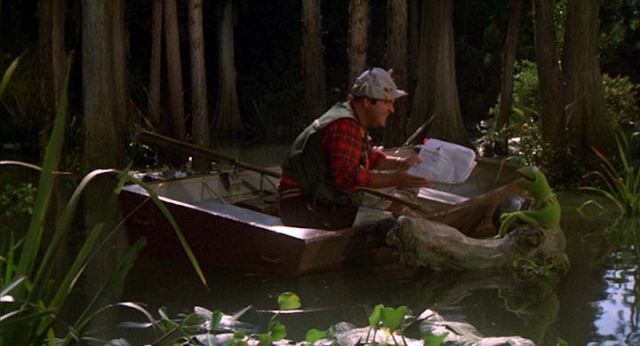


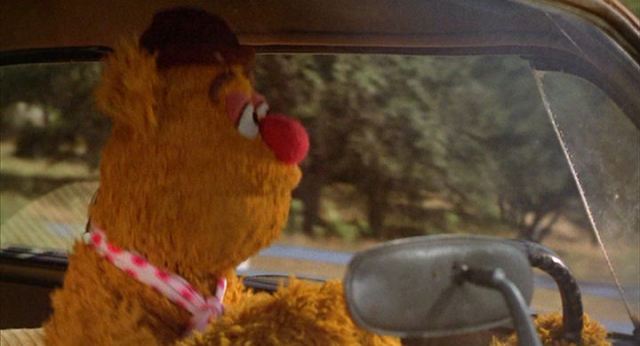



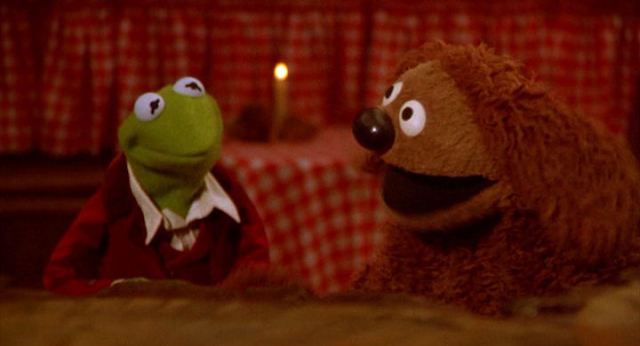
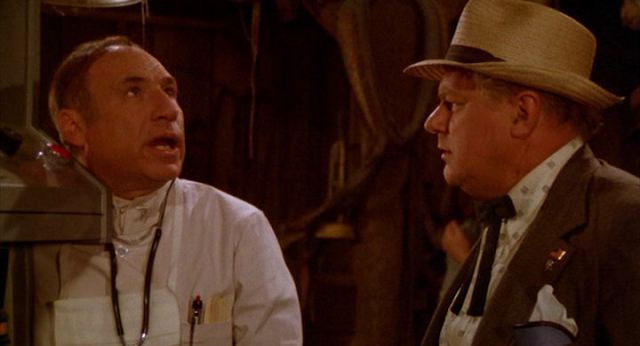


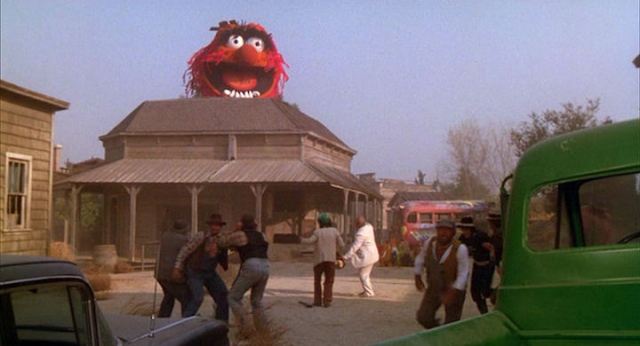

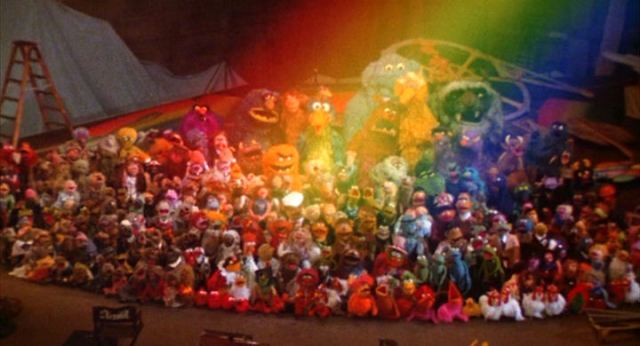
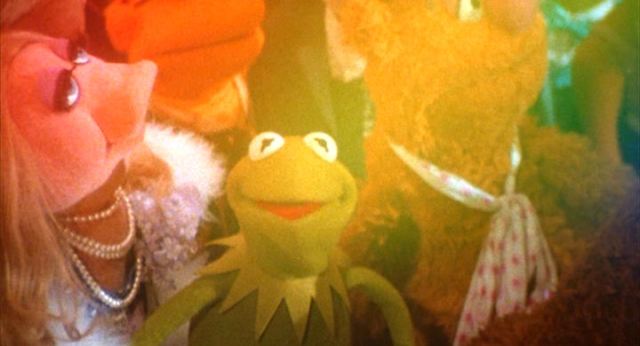


Great piece man. Great read. I enjoyed that one, big time.
It is a great flick, and now I want to watch it… its been so long (TOO long) since I’ve seen it.
You dont really think of all the Muppet stuff as “special effects” but when you point ’em out like that, it’s definitely easy to see, they were special, indeed.
Glad you gave so much attention to “Rainbow Connection” hauntingly beautiful song. When I did my Muppets review for the recent movie and I embedded the video in it, and I must have played that song 100 times. So great. Such a great tune. I got chills when they busted it out for the new movie.
😀
Excellent post, dude.
Sometimes I think the best special effects are the ones you don’t think of. 😀 Like Ebert choosing to believe that Kermit was pedaling the bike himself; if it looks real enough, why question it?
Thanks, man. I’m glad you appreciate the post; I kind of figured you would. 😀 It was a lot of fun to write, too, even if I had to go pretty far afield to find stuff out (the DVD I have, the Kermit’s 50th anniversary disc from Disney, has bupkus in the way of meaningful extras.) But it was a ton of fun to watch it again… still singing the songs under my breath a few days after.
such a great movie and a very good review, have to go and watch this now on my VCR (need to get it on DVD soon)…
Thank you, Rincewind! It’s definitely a good DVD purchase; like a lot of films it benefits from the proper widescreen presentation.
Fantastic review! I love this movie, which was why I was so happy with how 2011’s “The Muppets” came out — the humour was so similar, and the music was wonderful.
I have a friend who delights in long Muppet conversation with me. Despite the 20 years age difference, we share a love for Jim Henson (and she wishes for “I’m going to go back there someday” to be played at her funeral… What a tear-jerker!). I shall have to give her the link to this review; I think she’ll enjoy it.
Once again, brilliant work! 😀
Thank you very much! You’re right about how true to this movie The Muppets was… considering how easily that could have gone astray, it was a real pleasure to see how good it turned out.
That song at a funeral… now that’s a tear-jerker for sure. Almost brutally so.
This has reminded me that it has been far too long since I last saw this. Really must revisit it some time soon. I think I only ever saw it on my tiny TV when I was very little! Time to revisit it as an adult and really “get” the jokes.
Definitely… if you haven’t seen it since you were a kid, you absolutely should revisit it. Especially if it was on a “tiny TV”; this film deserves the widescreen treatment.
Fantastic write-up! God, I miss this movie. It’s been far too long since I’ve seen it and just reading about it makes me warm inside. Wonderful.
Thank you, Andy! “Makes me warm inside” is exactly how I feel about it as well. I can be in a pretty foul mood, and watching the Muppets will bring me right out of it.
I remember my brother getting sick when he was a kid, and we watched this movie over, and over, and over, and over again. Maybe 10 times over the course of two or three days. I can probably recite this movie from heart. And if it is ever on, I will ALWAYS take time to watch it.
Hopefully Disney will release a blu-ray version before too long.
It’s a good movie for a sick day, isn’t it?
I’m surprised Disney hasn’t already put out a Blu-Ray edition… you would think it would be a slam-dunk with either the theatrical or video release of The Muppets.
This is a tremendous film and great post. Your right this is not a kids movie per se just an entertaining film for everyone. Nice piece Morgan. Great note on Burton and Landis helping in production. 😉
Kermit: It’s too bad the dancing girls are on vacation. This crowd’s getting ugly.
Fozzie: If you think this crowd’s ugly, you should see the dancing girls.
Thanks, S. Great quote selection there… one of Fozzie’s better zingers.
Pingback: My Movie Alphabet | Morgan on Media
I saw your post at Keith’s and I followed it here. A very detailed post with lots of inside stuff and a fair amount of sentiment. You mentioned the Adventures of Robin Hood as a film that you love. I suggested to Keith a dual post on it, only now I think it would be more interesting and fun to get a dozen or more bloggers to post on the same day. Would you be interested?
I might be interested, though I’m not sure when I’d be able to do it. Unfortunately RH isn’t a film I have in my collection yet, and my DVD budget is going to be a pretty sparse for a few months.
I was just thinking out loud. We could plan it for anytime. By the way, I don’t think I was effusive enough about your Muppet post. It is delightful as well as informative. I’ll check back with you on the other thing when I find some other folks who might like to try this.
Thanks for the compliments on the Muppet post. Even with as many of these “Favorite Films” posts as I’ve done, it’s still probably the one I had the most fun doing, so I’m glad to see others enjoy it as well.
I’ll definitely be interested when you manage to track down some others. I’ll try and grab a copy of it by hook or by crook.